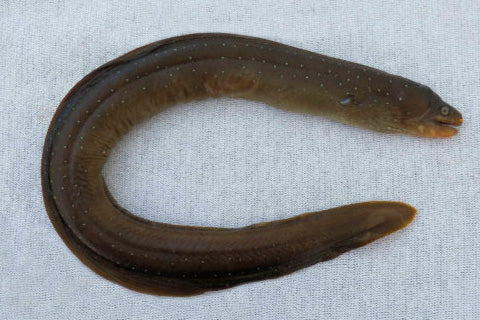
Palenose Moray Eel
Please contact us at info@baybridgeaquarium.com to confirm immediately availability. Livestock inventory is subject to change and prior sale. Fish shipments may take several days to fulfill.
Click Here to See Images
Basics
Scientific Name: Echidna nocturna
Family: Muraenidae
Origin: Pacific Ocean
Quick Facts
- Care Level: Easy
- Temperament: Semi-aggressive
- Lifespan: Unknown, likely 5-10 years or longer
- Reef Compatible: With Caution
- Water Conditions: 75-82° F, pH 8.0-8.4, sg 1.020-1.024
- Maximum Size: 2'4" (28")
- Diet: Carnivore
- Minimum Tank Size: 50 gallons (juvenile), 180 gallons (adult)
Overview
The Palenose Moray Eel is a less commonly seen species within the Echidna genus. They are olive green or brown in coloration, with many small white speckles covering their long, snakelike body. Like other morays, they have a large mouth and may relax with it slightly agape to better "smell" the water and their environment. This behavior is not a sign of aggression.
The tank should have a soft, sandy substrate and plenty of caves made of rock for them to hide in and establish a territory. It should have a tight, well fitted lid that may need to be weighted down if the eel is particularly large. While housing them with other fish is possible, they may make smaller fish a meal if not well fed and will most definitely eat hard-shelled invertebrates, so tankmates should be chosen very carefully. While they will not purposely bother or damage coral, their large adult size means they can accidentally topple rocks and corals. They should be the only eel in the aquarium.
This particular species is not particularly aggressive* but will be aggressive during feeding time when it smells food in the water. They should be fed frozen krill and other large shrimp.
* = While they are not aggressive, they may sometimes bite human hands or fingers, usually out of curiosity or even on accident while trying to take food, and should never be hand fed. They are not venomous, but their bites can become infected easily, so care should be taken to clean any wounds well and possibly seek medical attention.
